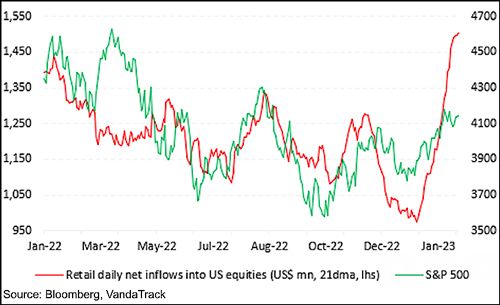U.S. Stocks: Why Acting Independently Has Never Been More Important
“Individual investors have been snapping up stocks at the fastest pace on record”
More than 20 years ago, when I was working for another company, I remember hearing a colleague say that he doesn’t look at his monthly 401k statements.
The implication was clear: He couldn’t bear to see the losses. At the time, the stock market was in a big downtrend after the dot.com bust.
I was reminded of what my former colleague said when I saw this Feb. 23 CNBC headline:
Retirees lost 23% of their 401(k) savings in 2022, Fidelity says
The S&P 500 index surrendered nearly 20% in 2022. As for bonds, another CNBC headline noted (Jan. 7):
2022 was the worst-ever year for U.S. bonds.
So, no doubt, there’s been a lot of pained looks on the faces of 401k participants as they’ve reviewed their statements during the past some months.
Even so, read this from Yahoo! News (Feb. 16):
Individual investors have been snapping up stocks at the fastest pace on record as U.S. equity markets have charged higher to start the year. Over the past month, retail investors funneled an average of $1.51 billion each day into U.S. stocks, the highest amount ever recorded.
This chart and commentary are from the February Elliott Wave Theorist, a monthly publication since 1979 which provides analysis of major financial and social trends:

Observe in the chart that it has taken massive retail commitment just to get the S&P to tack on a small upward leg in the opening weeks of 2023
The point is clear: Even after a substantial hit to their portfolios in 2022, Main Street investors are still optimistic about the prospects for the stock market.
Elliott Wave International believes that this is just one of many signals that investors should act independently from the crowd.
Let me conclude with this statement from a past Elliott Wave Financial Forecast, a monthly publication which provides Elliott wave analysis of major U.S. financial markets:
The market fools most of the people most of the time, but the Wave Principle alerts us to the point in the middle of a major trend when the reality of the new direction is unmistakable to reasonably observant investors.
This applies now: The reality of the new direction which began in January 2022 has yet to sink in with many investors. It may not be long before it does. That’s the message of the Elliott Wave Principle.
If you’re unfamiliar with the Elliott Wave Principle, read Frost & Prechter’s Wall Street classic, Elliott Wave Principle: Key to Market Behavior. Here’s a quote from the book:
In markets, progress ultimately takes the form of five waves of a specific structure. Three of these waves, which are labeled 1, 3 and 5, actually effect the directional movement. They are separated by two countertrend interruptions, which are labeled 2 and 4. The two interruptions are apparently a requisite for overall directional movement to occur.
[R.N.] Elliott noted three consistent aspects of the five-wave form. They are: Wave 2 never moves beyond the start of wave 1; wave 3 is never the shortest wave; wave 4 never enters the price territory of wave 1.
[Elliott] did not specifically say that there is only one overriding form, the “five-wave” pattern, but that is undeniably the case. At any time, the market may be identified as being somewhere in the basic five-wave pattern at the largest degree of trend. Because the five-wave pattern is the overriding form of market progress, all other patterns are subsumed by it.
Learn more by reading the entire online version of Elliott Wave Principle: Key to Market Behavior for free!
All that’s required for free access is a Club EWI membership.
Club EWI is the world’s largest Elliott wave educational community and is free to join. More than that, members enjoy complimentary access to a wealth of Elliott wave resources on investing and trading without any obligations.
Get your Club EWI membership now by following this link: Elliott Wave Principle: Key to Market Behavior — get free and instant access.
y market analysis to institutional and private investors around the world.